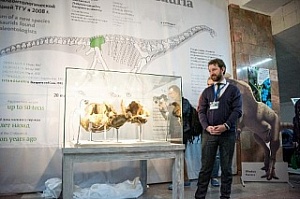Geobios has published an article by researchers from TSU, St. Petersburg State University, and the Zoological Institute of the Russian Academy of Sciences describing a new genus and type of dinosaurs. The remains of a fossil animal belonging to the taxon of the largest herbivorous lizards – sauropod – were discovered by scientists during an expedition in 2008. In the process of studying the fossils, paleontologists found anatomical features that distinguish this dinosaur from other well-known dinosaurs. The new genus was named Sibirotitan, and the species is Sibirotitan astrosacralis.
The remains of the giant animal were found in the Shestakovo 1
locality (Kemerovo Region, Western Siberia, Russia), which includes some
of the largest sites of the dinosaur and mammoth fauna in Russia. The
bone fragments were buried in the dense sandstone of the Ileks suite,
and it took the researchers several years of laboratory work to extract
them from the clumps of cemented rock. As a result, almost a whole
sacrum was assembled from some parts, and part of a scapula and cervical
vertebrae were assembled from numerous other pieces.
- The new kind of dinosaur is described by several isolated vertebrae,
which most likely belong to one individual. In addition, the foot
fragment described in 2002 refers to it. With Professor Alexander
Averyanov from the Zoological Institute of the Russian Academy of
Sciences working in our laboratory, we conducted a comparative analysis
of the remains with sauropods found in other countries. It turned out
that our lizard has anatomical features that distinguish it from all
known brethren, - says Stepan Ivantsov, a researcher at the TSU’s
Laboratory of Mesozoic and Cenozoic Continental Ecosystems.
A characteristic feature of the new genus is the presence of five
sacral vertebrae, sacral ribs oriented radially (in the form of a star),
and a special crest on the neural arc of the trunk vertebra. Ancient
lizards with such a skeletal structure have never been found anywhere.
Anatomical features and binding to the former habitat are recorded in
the Latin name of the new species - Sibirotitan astrosacralis. The first
part of the name indicates the giant size of a dinosaur, who cold have
been 20 meters long and weighed 50 tons.

Until recently, only one Russian find of dinosaur bones from the
Sauropod taxon was known. Several vertebrae of the ancient animal were
found in Transbaikalia. At the moment, Sibirotitan, whose age is about
100 million years, is the second sauropod described in Russia and the
oldest representative of titanosauriforms in Asia.
And unlike paleontological finds that are kept in museums of other Russian universities, TSU installed a unique exhibit in a place of free access –in the hall of the Center of Culture, where it is accessible to the maximum number of people.
Titanosauriforms are included in a taxon of herbivorous dinosaurs-sauropods, who lived in the Jurassic and Cretaceous periods on the territory of all modern continents. The largest specimens could reach a length of 35-40 meters and weigh up to 100 tons. At the same time, they had fairly small teeth (4-6 cm), which were used to tear off leaves.

